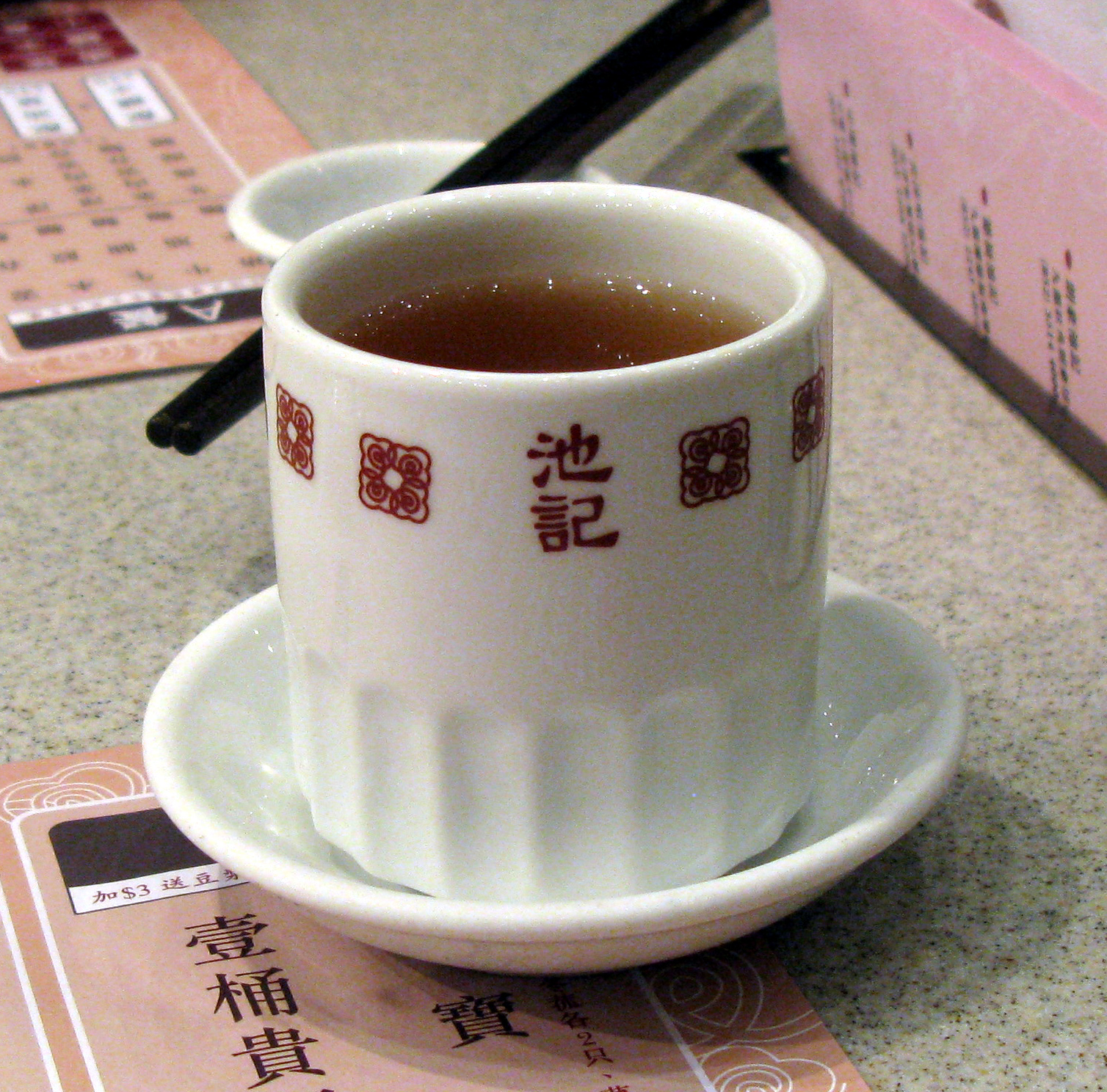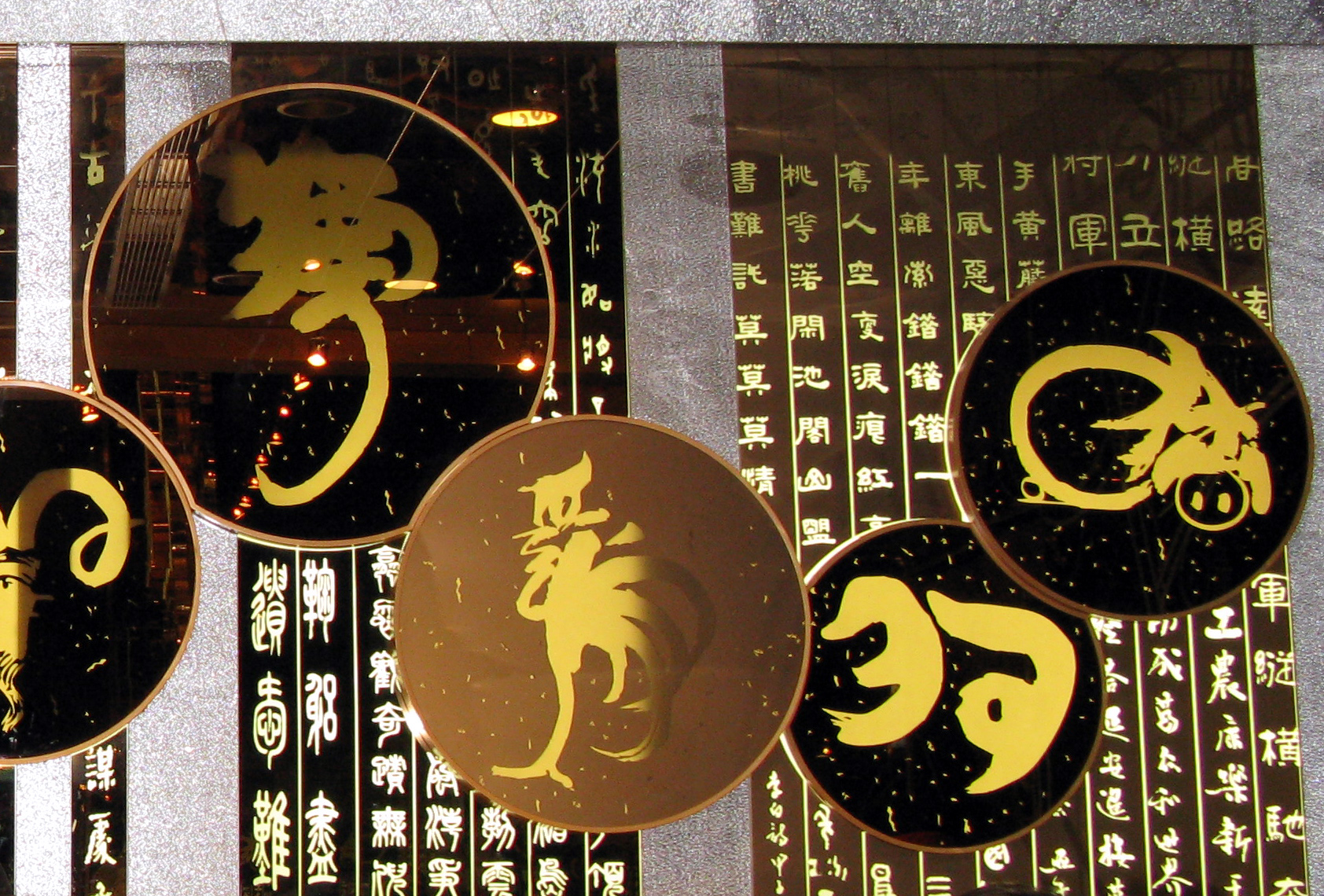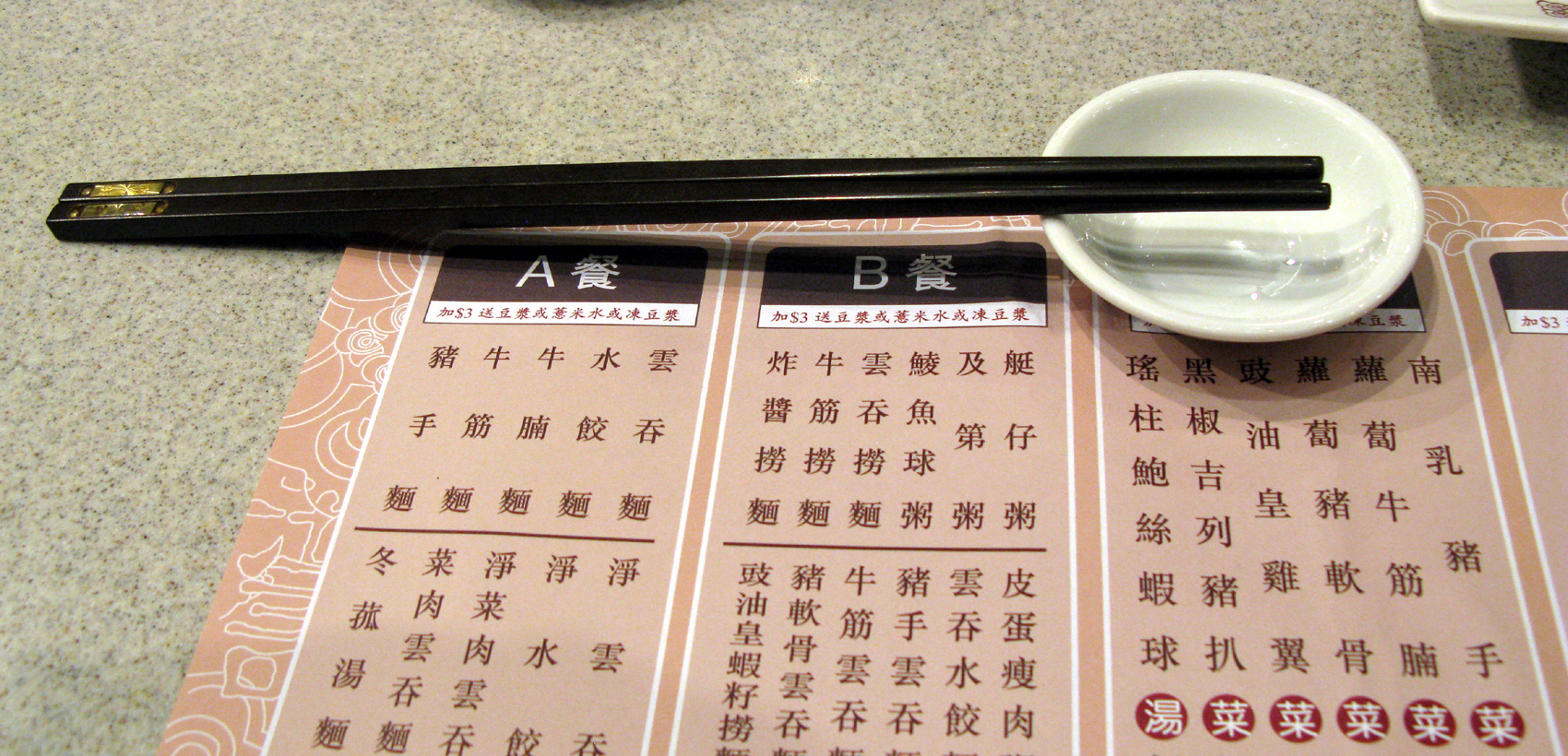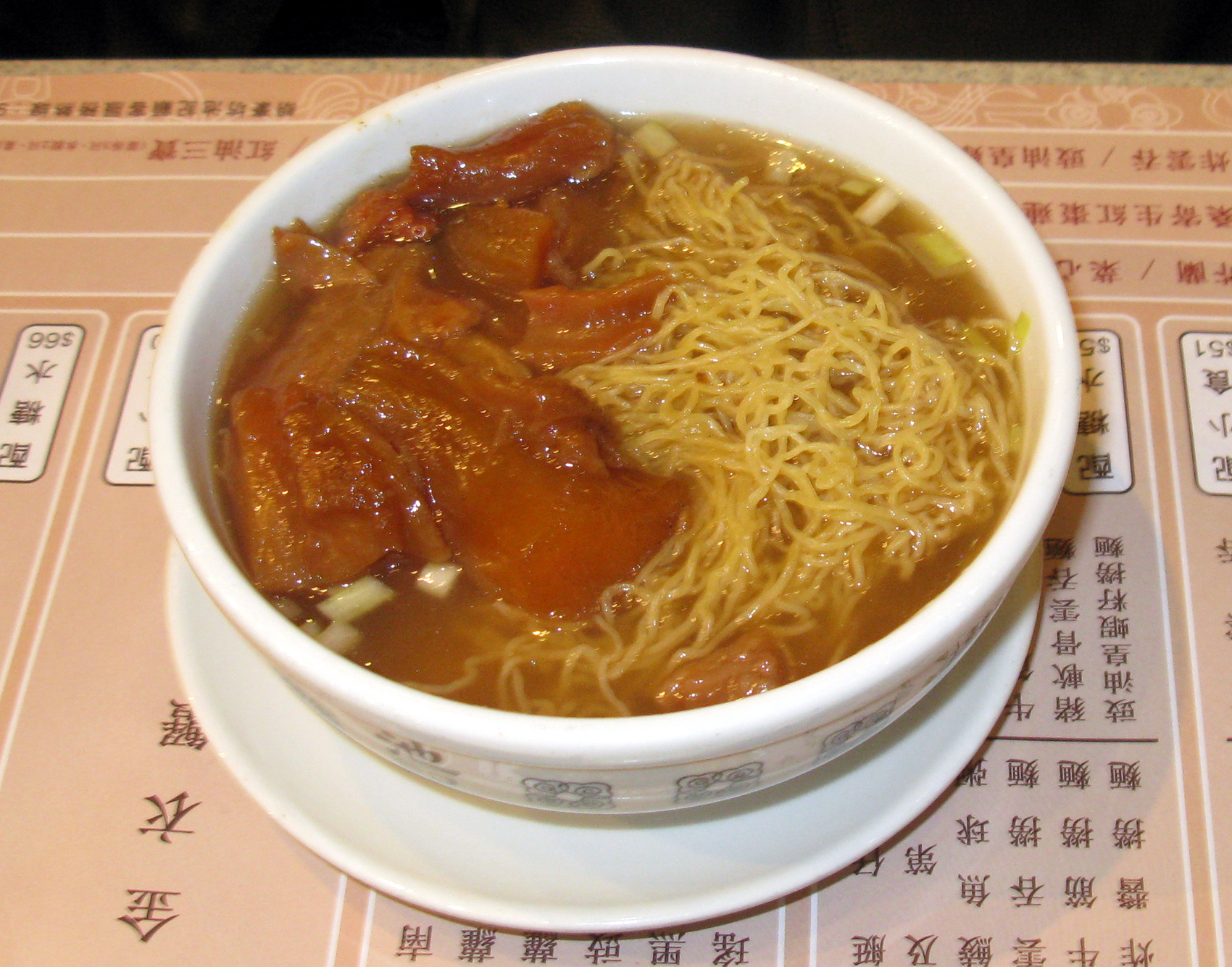Chee Kei (池記)
Langham Place
8 Argyle St., Shop 10, Level 4 (near Shanghai Street)
Mong Kok, Kowloon, Hong Kong
旺角亞皆老街8號朗豪坊4樓10號舖
(852) 3514-4000
www.cheekeiwonton.com
Hours: Sun-Sat: 11:00 a.m. – 11:00 p.m.
Vegetarian-friendly
Average for meal/person with complimentary cup of tea (no taxes and 10% service charge): HK$45-HK$80
Cash only
Rating: ◊◊◊½ (extremely good)
Other locations:
Shop No. F27, Telford Plaza Phase One
33 Wai Yip Street
Kowloon Bay, Kowloon, Hong Kong
九龍灣偉業街33號德福廣場一期F27號舖
(852) 2243-4022
Hours: Sun-Thurs: 7:15 a.m. – 10:45 p.m.; Fri-Sat: 7:15 a.m. – 11:00 p.m.
No.37 Lock Rd., G/F
Tsim Sha Tsui, Kowloon, Hong Kong
尖沙咀樂道52號地下
(852) 2368-2528
Hours: Sun-Sat: 11:00 a.m. – 10:30 p.m.
84 Percival St.
Causeway Bay, Hong Kong
銅鑼灣波斯富街84號地下
(852) 2890-8616
Hours: Sun-Mon: 11:00 a.m. – 10:30 p.m.
Chinese Club Building
21-22 Connaught Road, G/F-1/F
Central, Hong Kong
中環干諾道中21-22號華商會所大廈地下至1樓
(852) 2522-0786
Hours: Mon-Sun: 11:00 a.m. – 10:30 p.m.
Hong Kong (香港), one of the most densely populated global cities in the world, is prosperous and vigorous, buzzing with exuberant energy and teeming with unswerving vibrancy. Driven by a buoyant economy, burgeoning affluence, and entrepreneurial spirit, the City of Light and Life continues to celebrate its living culture of commerce, capitalism, and consumerism. For many people, locals and tourists alike, this flourishing world city, with its duty-free status, is a major international shopping destination. Replete with quaint street markets, quirky local shops, stylish fashion boutiques, chic designer galleries, colossal department stores, and palatial shopping malls, the high-rise hub is a treasure trove of sorts. From traditional Chinese medicinal herbs to authentic exotic, ethnic spices, from custom-made cheongsam dresses (長衫) to latest designer fashion items, and from Asian antique artefacts and collectibles to state-of-the-art electronic gadgets, the über-modern mega metropolis displays a rich profusion of diversity inherent in its cultural heritage.
Hong Kong may be a shopping paradise, but the alpha city’s passion for, or rather obsession with, food eclipses its love of shopping and stocks. All over the cramped cosmopolitan city-state, local culinary treats abound, from Cantonese comfort foods like the emblematic egg custard tart 蛋撻; the crowd-pleasing curry fish balls 咖喱魚蛋; the savoury sampan rice porridge 艇仔粥 partnered with “deep-fried devils” (油炸鬼) or “ox-tongue pastry” (牛脷酥); the regal roast suckling pig 烤乳猪; and the compelling claypot rice cooked with glistening waxed meats 臘味飯; to authentic, traditional Chinese exotica like the coagulated pork blood tofu 血豆腐; the classic cold Cantonese appetizer of an eccentric century egg (皮蛋) plated with pickled ginger root; the glorious golden “phoenix claws” 豉汁蒸鳳爪, marinated chicken feet braised in black bean sauce; the grand Guangdong five-snake soup 太史五蛇羹 finished with kaffir lime leaves and chrysanthemum flower petals; the sumptuous Shandong soup specialty 燕窩 made from the saliva-solidified nests of cave-dwelling swiftlets; and the prestigious and prized luxury foods like the aphrodisiac abalone, the coveted sea cucumber, the controversial shark fin, and the luxurious fish maw, highly revered sea treasures which can be found in the famous, festive Fujian delicacy “Buddha jumps over the wall” (佛跳墙). A humorous Chinese proverb succinctly summarizes the dizzying variety of Chinese dishes, many of which constitute part of the prominent culinary legacy of Guangdong: “A Cantonese will eat anything in the sky but airplanes, anything in the sea but submarines, anything with four legs but the table, and anything with two legs except his/her parents.”
Although rice may be the cornerstone staple of Chinese cuisine, noodles continue to remain a ubiquitous mainstay in this Asian style of cooking. After all, the Chinese invented noodles more than four thousands years ago. With over one thousand types of noodles in the Chinese culinary repertoire, they do take pride in their enduring, versatile culinary creation. And Hong Kongers love their oodles of noodles in all shapes, sizes, and styles, be it thin or thick, short or long, flat or round; be it wheat noodles, rice noodles, egg noodles, mung-bean noodles, or eel noodles; be it hand-pulled noodles, bamboo-rolled noodles, or knife-shaved noodles; be it retro cart noodles, dandan mein (擔擔麵), or lou shu fun (銀針粉). They could be boiled, steamed, braised, pan-fried, stir-fried, or deep-fried; they could be served hot or cold, dry, saucy, or soupy. The forms and variations are endless, and they are massively popular in this sophisticated city-state. From canvas-canopied food stalls and informal fast-food outlets to dim-sum tea houses and exclusive, extravagant restaurants, noodle delights are found in every corner of this Asian epicurean centre.
Like a true Hong Konger, I, too, have a longstanding love affair with noodles and yearned for an unadulterated taste of this universal favourite fare in this gourmet and shopping haven. It was during one of our shopping outings in Kowloon (九龍) that my mother and I found the occasion to indulge in the nutritious noodle nosh when we stopped at the Michelin-recognized eatery Chee Kei (池記) for a small bite to eat.
Among the five locations, the Chee Kei (池記) branch in Mong Kok (旺角) was conveniently stationed in the food court of the fifteen-storey fashionable landmark Langham Place (朗豪坊), a cool and modern shopping complex which is linked by bridge to the innovative and ultra-high-tech Langham Place Hotel (朗豪酒店), the sole five-star spa hotel situated in this Hong Kong district. Set in pale grey, crimson red, and earthy wood hues, the brightly lit milieu sported an aesthetic mix of traditional and modern Chinese décor. One of the side walls was graced with striking mirror panels embellished with golden Chinese poetic texts and encircled Chinese calligraphic characters representing the twelve animals of the Chinese zodiac. Appointed with marble-topped tables, accompanying brown chairs, steel light fixtures, and tasteful mirror and wood furnishings, the smartly designed space, small yet spacious, was ergonomically functional yet pleasantly inviting.
When we dropped by at around eight o’clock that Sunday evening, the urban dining spot was packed with patrons, and there was a small lineup in front of the outlet. Fortunately, the seat turnover was quite quick, and by 8:10 p.m., we were ushered to our table. Like in cha chaan tengs (茶餐廳), it was not uncommon to dap toi (搭檯) with other fellow diners, and that evening we shared a table with, coincidentally, two Sino-Canadians, a mother and her son, who were also here in Hong Kong for a visit. As soon as we were seated, one of the courteous and efficient waitresses poured each of us a complimentary cup of piping hot Chinese tea from the large brass tea pot which she was carrying.
Although the main draw at this reputable establishment is the Hong-Kong-style wonton noodles, the café-like hideout offers an assortment of other Chinese culinary comestibles including additional noodle dishes like zha jiang mian (炸醬麵), egg-enriched wheat noodles topped with ground pork that is stir-fried in a salty, fermented soybean paste; rice-oriented items such the signature golden crab congee spruced up with crab roe, ginger, and scallions (金皇蟹粥) and the fried vegetable rice studded with diced ham (菜飯); meat victuals like the Swiss chicken wings (瑞士雞翼) and the fried breaded pork chop heightened with black pepper sauce (黑椒吉列豬扒菜飯); nose-to-tail specialties such as the braised beef brisket and daikon (柱侯蘿蔔炆牛腩); and dessert delectables like the “Red and white,” a Cantonese hybrid concoction of sweet azuki bean soup and sweet soybean pudding (紅豆豆腐花). But the other appealing attraction of the casual locale was the flexible set meals composed of a combination of a principal plate and a side or dessert dish, and, if desired, for a small additional cost, one of the restaurant’s homemade Chinese beverages like the warm barley drink brewed with ginger (薏米水). From these various options which were outlined in Chinese on the paper placemat, we settled on two prix fixe menus to share. And like quick-service joints, it did not take very long for our four siu sik (小吃) selections to arrive at our table.
Indeed, I opted for a bowl of the iconic Cantonese wonton noodles (鮮蝦雲吞麵). There are many variations in flavour and texture on this seemingly simple theme of dumpling and noodles as there are cooks, but Chee Kei (池記) prepared this time-honoured Hong Kong classic in an authentic fashion. Here, the bamboo-pressed, egg-and-wheat-flour noodles, fine and long like capelli d’angelo, were doused in a steaming hot, brown bouillon bolstered with shrimp shells and pork bones, enhanced with flame-roasted dried flounder and dried Buddha fruit, and speckled with shrimp roe. A generous splash of red vinegar and a liberal dash of chilli oil from the set of table condiments added an acidic zing and piquant edge respectively to the subtle tastes of the al dente yellow threads and the light, aromatic consommé tinged with a touch of sweetness. Coyly concealed underneath the loose bed of smooth, springy strands of noodles, four bite-sized dumplings ( 雲吞) with goldfish-like tails floated at the bottom of the bowl. These swallowing clouds, delicate and plump, were snugly wrapped in velvety soft and silky smooth wonton skins which were paper-thin and translucent, faintly revealing the interior filling, a blend of fresh sea shrimp and minced semi-fat pork. Succulent and sweet, the predominant crustacean meat was firm and crunchy, lending a lively texture to the irregular-shaped Guangdong ravioli. Garnished with the typical sprinkling of chopped, fresh yellow chives, the well-balanced and well-executed ensemble was not only soul-soothing but also soul-satisfying. Delicious.
My mother’s jook sing mein (竹昇麵) of choice was essentially the same as mine save for the addition of a fourth component: braised beef tendon. Impeccably cooked, the handsome slices of softened, unctuous beef offal were not only fabulously flavourful, having absorbed all the flavours of the soy-dominant and spice-infused marinade, but the rich, hearty pieces were also so gelatinous and incredibly tender that they divinely melted in the mouth. Utterly toothsome.
Equally scrumptious were the housemade Chinese mud carp balls (炸鯪魚球). Here, as in other noodle and congee shops and other culinary outposts, the much-loved local snack standby was revived with an updated twist. Served piping hot atop a pallet of shredded fresh lettuce, the five hand-rolled, morsel-sized orbs of puréed dace, dressed without the habitual lard sheet wrappings, were freshly deep-fried from the kitchen. Crisp on the exterior yet soft and moist on the interior, the peppered spherical formations, specked with tiny flecks of chopped Chinese parsley and inflected with dried tangerine peel, were bouncy, spongy, and light. Presented in a diminutive dipping dish, the house preserved molluscan sauce made with fresh clams, fermented tofu, and orange zest, paired harmoniously with the fragrant and flavoursome freshwater fish balls, although the salty condiment concoction may be too pungent in taste for some, especially the faint-hearted and faint-palated. Superb.
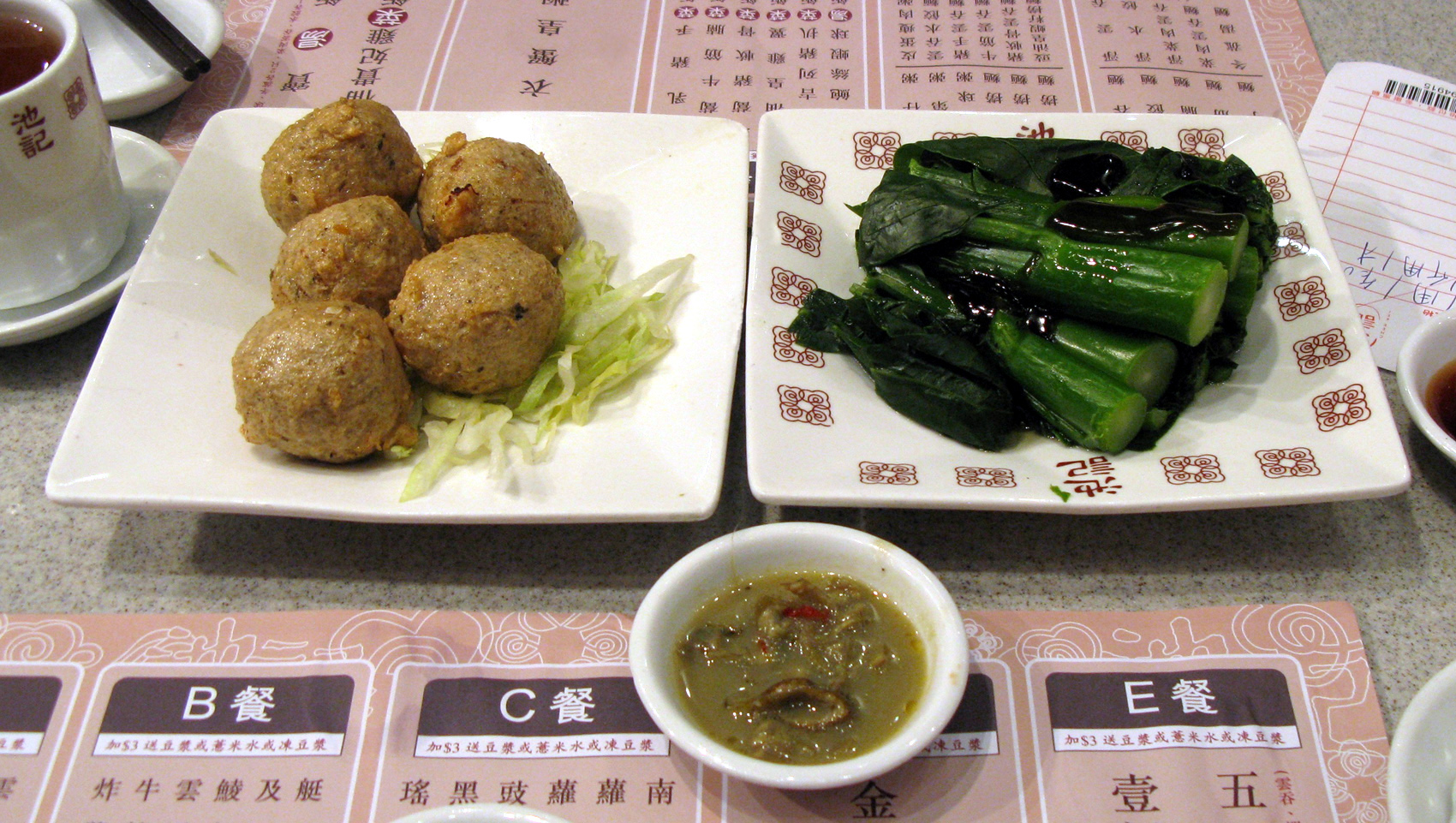
Siu sik (小吃) dishes, from right, counterclockwise: blanched choy sum (菜心) with oyster sauce (蠔油), deep-fried dace balls (炸鯪魚球), and accompanying preserved clam dipping sauce
The remaining siu sik (小吃) number was the most homey and humble dish of our dinner. In rich shades of dark green, the bundle of fresh choy sum (菜心) was merely blanched. Served on the side, the viscous oyster sauce (蠔油), which we liberally drizzled over the neatly trimmed brassica stalks, added a sweet and earthy saltiness to the sweet, crisp “vegetable hearts,” an ideal complement to the other small-portioned plates of the repast. Luscious.
Our healthy and heartwarming collation at Chee Kei (池記) assuaged our hunger and quelled my lust and nostalgia for wonton noodles. Set amidst the young and hip, commercial surroundings, the casual and convivial eatery, with its prompt and straightforward service, was an enjoyable place to nibble, nosh, and have an informal meal of quality comfort food fare, all prepared from scratch. And the pleasing part of our dining experience was that it was extremely affordable. And that alone was all the more reason for me to return to that trendy boutique I had visited earlier and to check out that cute, chic garment which had caught my eye and fancy.

